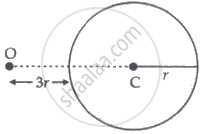Advertisements
Advertisements
प्रश्न
The power of a lens is +2.0 D. Find its focal length and state the kind of lens.
उत्तर
P = + 2.0 D
P = `1/("F" ("in meter"))`
`=> "F" = 1/ "P" = 1/2`
F = 0.5 m or 50 cm
∵ Power is (+ve)
∴ It is a convex lens.
APPEARS IN
संबंधित प्रश्न
Find the focal length of a lens of power −2.0 D. What type of lens is this?
You have two lenses A and B of focal lengths +10 cm and –10 cm, respectively. State the nature and power of each lens. Which of the two lenses will form a virtual and magnified image of an object placed 8 cm from the lens? Draw a ray diagram to justify your answer
A convex lens of focal length 25 cm and a concave lens of focal length 10 cm are placed in close contact with one another.
(a) What is the power of this combination?
(b) What is the focal length of this combination?
(c) Is this combination converging or diverging?
On reducing the focal length of a lens, its power ______.
How is accommodation produced?
If there is a convex lens of focal length 75 cm and a concave lens of focal length 40 cm, then calculate their combined power and combined focal length.
The power of lens depends on the focal length of the lens
Match the following:
| Column - I | Column - II | ||
| 1 | Retina | a | Path way of light |
| 2 | Pupil | b | Far point comes closer |
| 3 | Ciliary muscles | c | near point moves away |
| 4 | Myopia | d | Screen of the eye |
| 5 | Hypermetropia | e | Power of accommodation |
A convex lens with radii of curvature R1 = R2 is immersed in water. Assuming that the refractive indices of glass and water are 3/2 and 4/3 respectively, its focal length f1 in comparison to that in air, f, is ______.
A point object is placed at O in front of a glass sphere as shown in figure.

Show the formation of the image by the sphere.
